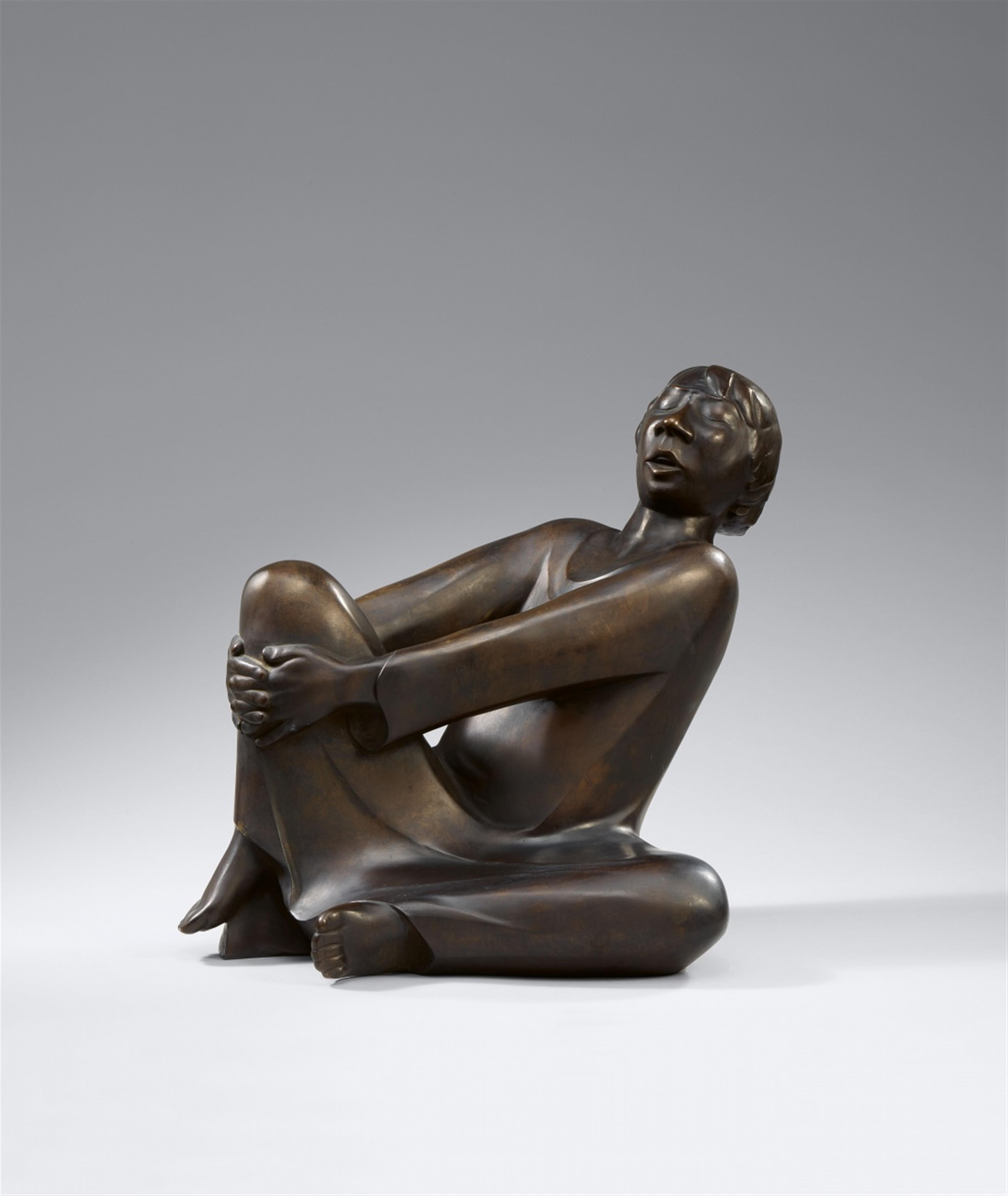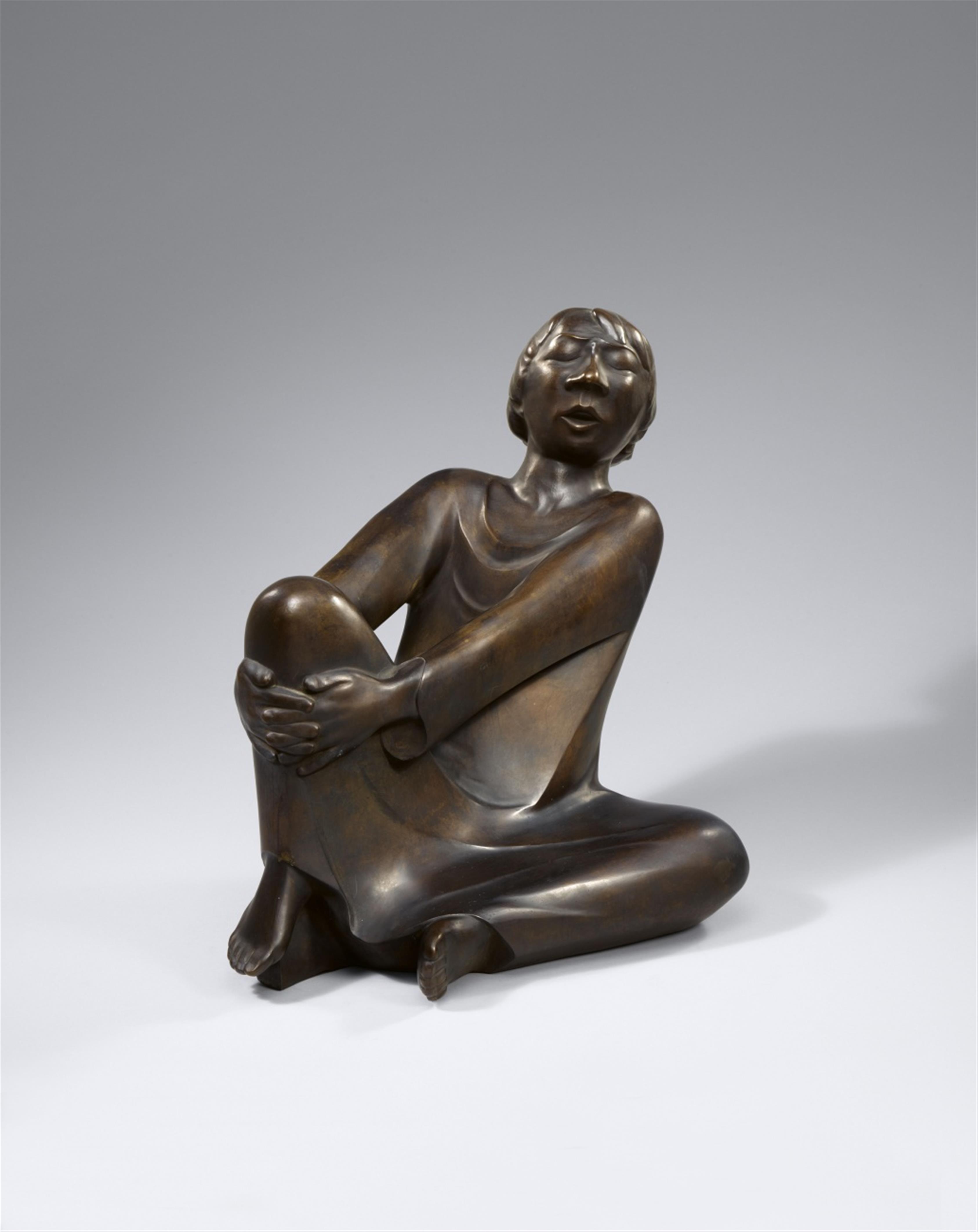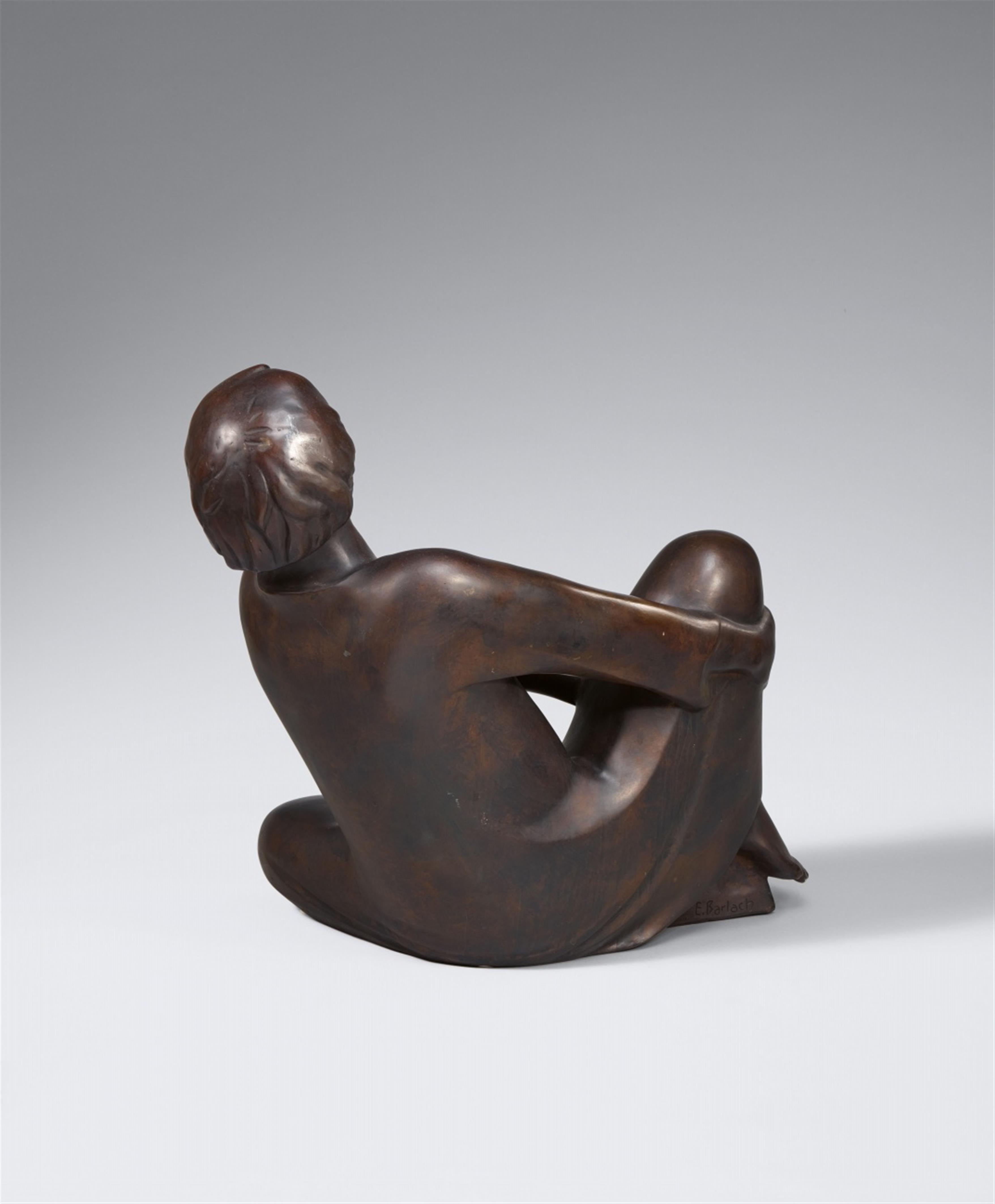Ernst Barlach
Der singende Mann
1928
Bronze Height 49.3 cm Signed 'E. Barlach' on the back of the base under the right foot and with hammered foundry marks "H. NOACK BERLIN" at the edge. From a total edition of 57 casts mentioned by Laur, of which approx. 16 were early lifetime casts from the edition of the Flechtheim Gallery. The work offered here is a cast from an unnumbered posthumous edition; according to information provided by the Estate of Ernst Barlach, Ratzeburg, it is an archivally documented piece for sale cast in the 1970s. - With lively dark brown patina, lightened in places. - At the back of the head with smaller whitish scratches on the surface.
“This much I've recognised”, wrote Barlach to the scholar of German literature Friedrich Düsel in 1891, “that in sculpture the antique spirit (I don't demand antique forms, as in the case of Thorvaldsen, but the simple grand spirit and purity and strictest correctness of the forms, particularly the drapery, of which no modern painter and much less sculptor has any idea - beauty, grandeur, the flow of lines [...]), the orientation towards the monumental have to be the driving forces.” (Ernst Barlach to Friedrich Düsel on 13 June 1891, in: Briefe I, 1888-1924, Munich 1968, no. 45, p. 165). Over 35 years later - in the meantime Barlach had successfully completed his studies in Dresden as a master-pupil of Robert Diez (1844-1922), first travelled to Paris in 1895/96, pursued (in a certain sense) a departure from the classicist ideal and glorified the omnipresent French naturalism of the late 19th century - Barlach conceived one of his most widely disseminated figures, the “Singender Mann”. This was not the only work with which Barlach met the challenge he had once laid down for himself in purest contemplation: an austere formal composition, simple drapery falling in loose folds, reduced to almost Cubist forms and nonetheless with an elegant ornamental arc in the “flow of lines”.
A physiognomy that had come to characterise the artist's work conveys a distinctive concept and independently responds to an iconographic gesture, a moving statement. Barlach may have been pursuing a sacral, perhaps also liturgical, background with the delightful, leaned-back and relaxed pose and, with the full-throated singing of the man, he cast a figure which he used to describe as a “human situation in its nakedness between heaven and earth” (Ernst Barlach, Ein selbsterzähltes Leben, Kritische Textausgabe, ed. by Ulrich Bubrowski, Leipzig 1997, p. 72).
After the death of his gallerist Paul Cassirer in 1926, Alfred Flechtheim became responsible for handling Barlach's sculptural work and encouraged the sculptor, who had been “fixated” on wood up to that time, to increasingly utilise bronze to realise his sculptures. Thus, after the 1927 monument in Güstrow, the “Singender Mann” was among the first sculptures that Barlach conceived with “passion and conviction” in what was a new material for him.
Catalogue Raisonné
Laur 432; Schult I 343
Certificate
We would like to thank Galerie Nierendorf, Berlin, as well as Ernst Barlach Lizenzverwaltung, Ratzeburg, for documentary archive information.
Provenance
Ernst Barlach Nachlaßverwaltung Nikolaus Barlach; Galerie Nierendorf Berlin (1978); Private collection, Rhineland
Literature
I.a.: Bronzen von Ernst Barlach, Galerie Flechtheim, November/Dezember 1930, exhib. cat. Berlin/Düsseldorf 1930, no. 19; Alfred H. Barr, Omnibus, German Sculpture, Berlin/Düsseldorf 1932, p. 38-42; Marguerite Devigne, Ernst Barlach, in: Les Beaux-Arts, Brussels 1935, p. 14; Carl Dietrich Carls, Ernst Barlach, Das plastische, graphische und dichterische Werk, 5th ed., Flensburg/Hamburg 1950, p. 58; Paul Fechter, Ernst Barlach, Gütersloh 1957, p. 35; Franz Fühmann (ed.), Ernst Barlach, Das Wirkliche und Wahrhaftige, Wiesbaden 1970, p. 159; Kunstblätter der Galerie Nierendorf, Ernst Barlach. Plastik, Zeichnungen, Graphik, 13 Sept.-5 Dec.1978, Berlin, September 1978, cat. no. 41 with illus. no. 21 (this cast); Anita Beloubek-Hammer, Ernst Barlach, Plastische Meisterwerke, Leipzig 1996, p. 116 f.; Helga Thieme, Ernst Barlachs Skulptur "Der singende Mann" in der Ausstellung "Neue deutsche Kunst", Oslo 1932, in: exhib. cat. Rostock 1998, pp. 310 ff.
Exhibitions
Berlin 1978 (Galerie Nierendorf), Ernst Barlach, Plastik, Zeichnungen, Graphik, cat. no. 21 (this cast)
According to Laur, casts can be found in the following museum collections: Neue Nationalgalerie, Berlin; The Cleveland Museum of Art, Cleveland/Ohio, USA; Museum am Ostwall, Dortmund; Ernst Barlach Haus, Hamburg; Sprengel Museum, Hanover; Kunsthalle Kiel; Museum Ludwig, Cologne; Kunsthalle Mannheim; Pinakothek der Moderne, Munich; Lyman Allyn Museum, New London/Connecticut, USA; Museum of Modern Art, New York, USA; Germanisches Nationalmuseum, Nuremberg; Schloss Gottorf, Schleswig; Staatliches Museum Schwerin; Rathaus Wedel, Private possession (one numbered cast 4/10); Ernst Barlach Stiftung Güstrow; Hamburger Kunsthalle; Von der Heydt-Museum Wuppertal






